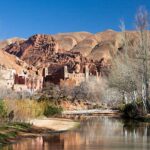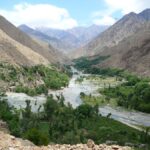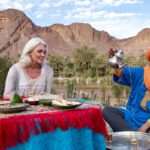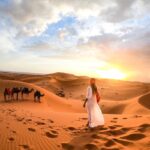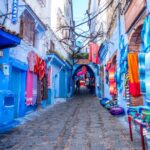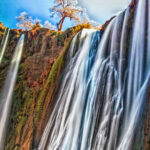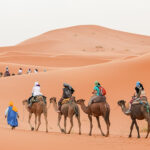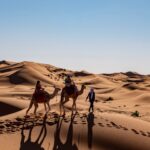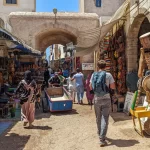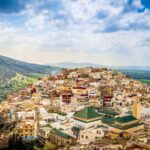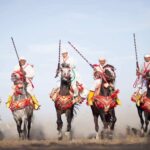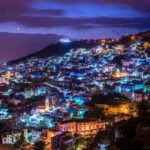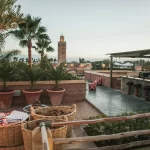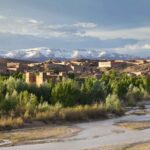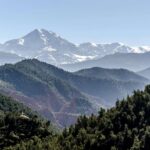Welcome to the enchanting world of the Sahara Desert, a vast expanse of rolling dunes and mystical landscapes that have captivated travelers for centuries. Morocco, with its rich history and vibrant culture, offers a unique way to explore this otherworldly region—on the back of a camel. “Camel Rides in Morocco: An Unforgettable Sahara Desert Journey” is not just about traversing the sandy plains; it’s an immersion into a deeply rooted tradition that echoes the footsteps of the ancient nomads. For those looking to embark on this adventure, understanding how to plan a Morocco Sahara Desert trip is crucial. Here’s what you need to know before you go.
Table of contents
- The Cultural and Historical Significance of Camels in Morocco
- Preparing for Your Morocco Camel Ride Adventure
- Types of Camel Rides in Morocco Sahara Desert
- Navigating the Desert: A Guide’s Insight
- Sustainable and Ecological Tourism
- Connecting with Local Cultures
- Your Sahara Desert Experience
- Beyond Morocco Camel Ride: Extended Activities and Experiences
- Conclusion: A Journey of Discovery

Camel Trekking Adventure in the Sahara Desert
The Cultural and Historical Significance of Camels in Morocco
Camels, often referred to as the ‘ships of the desert,’ have been integral to North African cultures for thousands of years. In Morocco, these majestic creatures are not only a means of transportation but also a symbol of survival and resilience. The relationship between Moroccans and their camels is woven into the fabric of daily life, especially in the communities bordering the Sahara.
Traditional Uses of Camels
Historically, camels in Morocco were essential for crossing the vast and treacherous terrains of the Sahara. They were used by traders and nomads alike, carrying goods along the ancient salt routes that connected distant cities across the desert. Today, while modern vehicles have taken over much of the transport duties, camels still play a significant role during cultural festivals and in rural areas where traditional ways are preserved.

Camel Caravan in the Moroccan Desert
Symbolism and Cultural Heritage
For the Berber and Nomadic tribes of the Sahara, camels symbolize strength, endurance, and adaptability—traits that are revered in these harsh desert environments. The annual festivals, such as the Tan-Tan Moussem, showcase camel races, beauty contests, and trading, highlighting their significance in the social and economic spheres of Moroccan desert communities.
By engaging in a camel ride across the Sahara, visitors are not just participating in a tourist activity; they are stepping into a centuries-old tradition that offers a profound connection to the land and its people.
Preparing for Your Morocco Camel Ride Adventure
Embarking on a camel ride through the Sahara Desert is an adventure that requires some preparation. Ensuring you have the right information and essentials can make the difference between a memorable experience and a challenging ordeal.
Safety Tips and What to Expect
First and foremost, safety is paramount. Camel riding, for all its exotic allure, comes with its own set of challenges. It’s essential to listen to your guide and follow their instructions carefully. Here are some tips to keep in mind:
- Hydration: The desert can be deceptively draining. Even if you do not feel thirsty, drink water regularly to prevent dehydration.
- Sun Protection: Wear a wide-brimmed hat ( Or buy the blue veil Kasbah Ait Ben Haddou on the way), sunglasses, and apply sunscreen frequently. The sun in the Sahara is particularly intense.
- Dress Appropriately: Wear long pants and a long-sleeved shirt to protect your skin from the sun and the camel’s rough hide. Traditional Moroccan scarves or turbans can be used to cover your head and face from sun and sand.
- Listening to Your Guide: Your guide knows the terrain and the behavior of the camels. Their instructions are crucial for a safe and enjoyable trip.

Guided Camel Ride Under the Moroccan Sun
Here are some refined tips for riding a camel, neatly categorized to enhance readability and provide clear, practical advice for first-time camel riders:
Understanding Camel Behavior
Camels are unique animals with distinct behaviors that differ significantly from horses. Here are a few key points to keep in mind:
- Beware of Bites and Kicks: Unlike horses, camels might not respond well to being petted or fed by strangers. It’s best to keep a respectful distance unless guided otherwise by your handler. Remember, camels can kick in all four directions, a stark contrast to the more limited kicking range of horses.
- Temperament: While it’s true that camels can kick and bite, they are generally known for being patient and docile when properly handled. Trust your instincts and follow the guidance of your guide to interact safely with these animals.
Mounting and Dismounting Your Camel
Getting on and off a camel is an experience unlike any other due to their height and the way they rise and lower. Here’s how to do it safely:
- Kneeling Position: Ensure the camel is kneeling before you attempt to mount. Your guide will usually command the camel to lower itself, but ask for assistance if you’re unsure.
- Boarding the Camel: Place your left foot in the stirrup, then swing your right leg over the camel’s back—much like mounting a horse. Secure yourself by holding onto the saddle.
- As the Camel Rises: Camels stand up back legs first, which can feel unsettling. Lean back slightly to balance yourself as the camel stands. Once it’s fully upright, you can adjust your seating position for comfort.
Controlling Your Camel
Camels are typically controlled with reins, much like horses, but there are some nuances to be aware of:
- Using the Reins: The right rein is used to direct the camel, helping it turn. The left rein often controls the speed.
- To Move Forward: Pull gently on both reins. Camels respond to steady, gentle pressures rather than sharp tugs.
- To Stop: To bring your camel to a halt, a gentle tug on the left rein should suffice. If you need to turn, loosen one rein while pulling tighter on the other.
- Communication: Always keep the reins steady and communicate your intentions clearly through them. Sudden movements or inconsistent commands can confuse the camel.

Intimate moment between a tourist and a camel
General Riding Tips
- Stay Relaxed: Camels can sense when you’re tense. Try to relax your body and stay calm to keep the camel at ease.
- Follow the Leader: Your camel is likely part of a caravan, and these animals are used to following the lead camel. Trust in this natural behavior to guide your journey.
- Enjoy the Ride: Camel riding is a unique experience that connects you to centuries of desert culture. Embrace the slow, swaying pace of your camel and take in the panoramic views of the desert.
By understanding and respecting the nature of camels and following these practical tips, you can ensure a safe and enjoyable camel riding experience. Whether you’re traversing the majestic dunes of the Sahara or exploring a desert oasis, riding a camel offers a profound connection to the landscapes and rhythms of desert life.
What to Wear and Bring on Your Morocco Camel Ride
Packing the right items can enhance your comfort and enjoyment during the camel ride. Here’s what you should consider bringing along:
- Comfortable Footwear: Closed shoes that can handle sandy and sometimes rocky terrain are best.
- Layered Clothing: Desert temperatures can fluctuate dramatically between day and night. Layered clothing allows you to adjust to changing temperatures.
- Camera and Binoculars: The Sahara offers breathtaking views and wildlife spotting opportunities. A good camera can help you capture these memories, and binoculars will enhance your viewing experience.
- Backpack: A small backpack is useful for carrying water, snacks, and personal items. Make sure it’s comfortable to wear while riding.
To ensure you’re well-prepared for the desert conditions, check out our guide on what to pack for a Morocco Desert tour.

Desert Camel Caravan in Morocco
Types of Camel Rides in Morocco Sahara Desert
Morocco offers a variety of camel ride experiences tailored to different interests and time frames. Whether you’re looking for a short excursion or a multi-day adventure, there’s an option to suit your needs.
Different Tour Options
- Short Excursions: Typically lasting a couple of hours, these rides offer a stunning sunset camel ride in Agafay Desert. This location is ideal for first-time riders and seasoned explorers alike. Enchanted by the rocky landscapes and the spectacular sunsets, participants in these short excursions receive a perfect introduction to the beauty of Morocco’s desert environments, distinct from the traditional sandy dunes, but equally mesmerizing.
- Overnight Safaris:For a deeper dive into the desert experience, overnight safaris involve camping under the stars in breathtaking locations. These Morocco desert tours often include traditional Berber meals and music, providing a cultural immersion alongside the adventure. As you settle in for the night amidst the expansive dunes of Erg Chebbi, you’ll experience the magic of the Sahara under a canopy of stars. This setting offers an unparalleled opportunity to connect with the vastness and silence of the desert, making it a memorable part of your Moroccan journey.
- Extended Treks: Lasting anywhere from a few days to a week, these treks allow you to explore extensive tracts of the Sahara. They provide an unparalleled opportunity to disconnect from modern life and engage deeply with the natural and serene desert environment.
Thematic Camel Rides in Morocco
- Cultural Tours: These focus on the historical and cultural aspects of the Sahara and its inhabitants. You might visit ancient trade routes, learn about local crafts, and interact with nomadic tribes.
- Wildlife Safaris: While the Sahara may seem barren at first glance, it is home to diverse fauna. These safaris focus on spotting and learning about the desert’s wildlife, such as the Fennec fox or various migratory birds.
Each type of Morocco camel ride offers a unique way to experience the vast beauty of the Sahara Desert and provides visitors with choices that cater to their personal travel goals.

Restful Break During a Moroccan Camel Safari
A Closer Look at Camel Welfare
When embarking on a camel ride in the Sahara Desert, it’s crucial to consider the welfare of the camels, which are central to this experience. Ethical considerations should guide your choice of tour operators to ensure that the animals are treated with respect and care.
Ethical Considerations of Camel Rides in Morocco
Camels are remarkably resilient animals adapted to the harsh desert environment, but they still require proper care and humane treatment. Here are some ethical considerations to keep in mind:
- Proper Loading: Camels should not be overloaded. The weight they carry, including that of the rider and any gear, should be appropriate for their size and strength.
- Health Care: Ethical tour operators provide regular veterinary care to ensure their camels are healthy and fit for the journeys they undertake.
- Rest Periods: Camels need adequate rest periods, especially during long rides. This not only helps maintain their health but also their ability to work effectively.
Choosing Responsible Tour Operators
Selecting a tour operator who prioritizes camel welfare is not only ethical but enhances the overall quality of the experience. Here’s how you can choose responsibly:
- Check Reviews: Look for reviews from previous travelers. Positive feedback about the treatment of camels can be a good indicator of responsible practices.
- Ask Questions: Don’t hesitate to ask operators about their practices regarding camel care. A transparent operator will be happy to discuss their animal welfare policies.
- Look for Certifications: Some operators may have certifications from wildlife or animal welfare organizations. These can be a sign of adherence to higher standards of care.
Navigating the Desert: A Guide’s Insight
A knowledgeable guide is invaluable on a Sahara camel ride, providing not only navigation and safety but also enriching the journey with cultural and historical insights.
Role of the Guide
Guides play multiple roles during your desert adventure:
- Safety: They ensure the safety of both the camels and the riders, managing any situations that arise and making sure that everyone adheres to safety norms.
- Navigation: The Sahara can be disorienting, and a skilled guide navigates with ease, knowing the best routes and times to travel.
- Educator: Guides often share stories and facts about the Sahara Desert, its history, and its ecology, enhancing the depth of your experience.
Environmental and Cultural Education
The educational aspect of Morocco camel rides can significantly enhance the appreciation of the desert’s environment:
- Flora and Fauna: Guides can point out the unique adaptations of desert plants and animals, explaining how they survive in such an extreme environment.
- Cultural Insights: Through interaction with guides, often members of local communities, travelers gain insight into the local customs, traditions, and way of life.
- Conservation Efforts: Guides can also inform tourists about conservation efforts in the area, highlighting the importance of preserving this unique landscape.
Guides are not just leaders; they are custodians of the desert’s secrets and stewards of its future, offering a bridge between visitors and the mystic Sahara.
Our guides are seasoned professionals, many of whom have worked extensively with Marrakech Desert Trips, ensuring a safe and enlightening journey.

A Guide and His Camel in the Moroccan Desert
Sustainable and Ecological Tourism
Promoting sustainable tourism in the Sahara Desert is essential to preserve its unique landscapes and biodiversity for future generations. Here’s how tourists and tour operators can contribute to this goal:
Impact of Tourism on the Sahara
While tourism brings economic benefits, it can also have detrimental effects on the environment if not managed properly:
- Erosion and Degradation: Over-tourism can lead to soil erosion and vegetation loss, especially around popular sites.
- Waste Management: Proper disposal of waste is crucial in maintaining the ecological balance of the desert. Tour operators and tourists alike should adhere to strict waste management protocols to ensure that litter does not degrade the pristine environment.
- Water Resources: The scarcity of water in the desert makes it vital to use this resource wisely. Tour operators should implement water-saving measures and educate tourists on the importance of conserving water during their visit.
Promoting Sustainable Practices
There are several ways to promote sustainability while enjoying the majestic beauty of the Sahara:
- Eco-friendly Tours: Choose desert tour operators who use environmentally friendly practices, such as solar power for camping sites or waste recycling programs.
- Minimizing Footprint: Travelers should be conscious of their environmental impact, adhering to guidelines like ‘leave no trace’ to minimize their footprint.
- Supporting Conservation Efforts: Participate in or donate to conservation projects aimed at preserving the Sahara’s ecosystem and wildlife.
Connecting with Local Cultures
Camel rides in Morocco Sahara offer a unique opportunity to connect with the local Berber and Nomadic tribes, providing a deeper understanding of their rich cultural heritage and lifestyle.

A Rest Stop in the Moroccan Desert
Interacting with Local Communities
- Home Visits and Meals: Some tours offer visits to local homes or meals prepared by local families, which not only provides a taste of authentic cuisine but also supports the local economy.
- Crafts and Souvenirs: Purchasing locally made crafts and souvenirs can help sustain traditional crafts and provide a direct economic benefit to artisans.
Understanding and Respecting Local Traditions
- Cultural Sensitivity: Learning about and respecting local customs and traditions is crucial. This includes dressing modestly, understanding local norms, and engaging respectfully.
- Language and Communication: Even basic phrases in the local languages (Arabic and Berber dialects) can go a long way in showing respect and enhancing communication.
Your Sahara Desert Experience
From the moment you mount your camel to the time you dismount under a starlit sky, every aspect of the Sahara Desert experience promises to be unforgettable.
What to Expect During the Camel Ride
- Riding Dynamics: Riding a camel is unique; their gentle, rolling gait is surprisingly soothing once you get used to the rhythm.
- Scenery: Expect a panoramic view of endless dunes, changing colors during sunrise and sunset, and an unparalleled sense of vastness.
Highlights of the Desert Landscape
- Oases: Discovering an oasis amidst the arid landscape can be a surreal experience, with lush vegetation and water sources that attract local wildlife.
- Star-Gazing: The Sahara is known for its clear skies, making it an ideal spot for stargazing. Many find this to be one of the most magical parts of their journey.

Guided Camel Tour in the Dunes of Morocco
Beyond Morocco Camel Ride: Extended Activities and Experiences
To enhance your Sahara adventure, consider exploring beyond the camel ride in Morocco with a variety of thrilling and enriching activities:
- Sandboarding: Experience the excitement of sandboarding down the sweeping dunes. It’s a fun and exhilarating way to interact with the desert landscape.
- ATV Rides: For those looking for more adrenaline-pumping action, ATV rides across the dunes offer a fast-paced way to explore larger areas of the desert.
- Fossil Hunting: The Sahara Desert is rich in geological history, with areas known for their fossils. Guided fossil hunting tours can provide a fascinating glimpse into the ancient past, revealing the desert’s prehistoric marine life.
- Visiting the Nomads: Spend time with Nomadic tribes to gain insight into their traditional ways of living. These visits can include sharing meals, learning about their daily routines, and understanding their resilient lifestyle.
- Exploring the Ksars and Khetttaras: Discover the ancient ksars (fortified villages) and the khetttaras (traditional underground irrigation systems) which are crucial to understanding the historical settlement and agricultural practices in the harsh desert environment.
Conclusion: A Journey of Discovery
“Camel Rides in Morocco: An Unforgettable Sahara Desert Journey” is more than just a travel experience; it’s an opportunity to connect with nature, explore rich cultures, and step back into a simpler time. Riding through the Sahara on the back of a camel offers a profound sense of peace and solitude, while the activities surrounding the ride immerse you in the vibrant life and traditions of the desert people.
As you prepare to leave the vastness of the Sahara, remember that the desert’s beauty and tranquility should be preserved for future generations. Travel responsibly, respect the local customs, and contribute positively to the conservation efforts.
Whether you’re watching the sunset paint the dunes in hues of gold or listening to the tales of the desert under a canopy of stars, your camel ride in the Moroccan Sahara will be an adventure that stays with you forever. Embrace the journey, and carry the spirit of the Sahara with you long after you return home.
Frequently Asked Questions:
- What Is It Like to Ride a Camel?
- Riding a camel offers a truly remarkable and unique experience. While it may not be the most comfortable mode of transportation initially, the awe-inspiring feeling of being atop a camel as it gracefully traverses the sandy terrain is unparalleled. You can sense their strength and elegance with every step. This adventure provides a unique perspective of the surrounding landscape and desert, leaving you with a genuine sense of exploration and wonder.
- Are Camels Stronger Than Horses?
- Comparing the strength of camels to horses involves various factors including size, weight, climate, and terrain adaptability. Camels are exceptionally strong, evolved to endure harsh desert conditions and can sustain themselves for extended periods without food or water. They are capable of carrying heavy loads over long distances in hot climates. In contrast, horses are typically better adapted to colder environments and may not be as efficient in long-distance transportation in harsh climates as camels.
- Is There a Weight Limit for Camel Riding?
- While there is no strict weight limit for camel riding, adhering to general guidelines ensures the safety and comfort of both the rider and the camel. It is typically recommended that riders weigh no more than 220 pounds. In Morocco, a popular destination for camel riding, there are also height and age considerations, especially for children, who are generally required to be between five and seven years old to participate.
- Are Camels Safe to Ride?
- Camel riding in Morocco is widely regarded as safe, even for children as young as two or three years old. Camels are known for their gentle nature and have been reliable working animals in the region for centuries. Their ability to endure long journeys without fatigue and their resilience in harsh conditions make them well-suited for navigating diverse terrains, including rocky landscapes.
- Is Riding a Camel Uncomfortable?
- Contrary to common belief, camel riding can be quite comfortable. In Morocco, where camel riding is a popular tourist activity, specially designed saddles with cushioned seats and high backs are used to ensure a comfortable ride, even on uneven terrain. Furthermore, the camel’s body provides shade, offering a cool respite from the sun’s heat. While some initial discomfort is possible, many find camel riding to be a delightful and enjoyable experience.
- What Is Camel Trekking?
- Camel trekking in Morocco offers tourists a unique opportunity to explore the country’s breathtaking landscapes. Ranging from short excursions to multi-day journeys, camel treks allow riders to traverse majestic sand dunes, valleys, and other natural wonders. Beyond the scenic beauty, camel trekking also provides insights into the cultural significance of these animals in the desert country. Though physically demanding, camel trekking is an unforgettable experience that creates cherished memories.
- Can You Go Camel Riding in Morocco?
- Camel riding is a highly sought-after activity in Morocco, offering visitors a scenic journey through the captivating desert scenery. Perfectly adapted to the arid environment, camels are ideal companions for extended rides. Renowned destinations for camel riding include the Sahara Desert, Marrakesh, and the Draa Valley. Riding a camel provides a distinctive and memorable way to experience Morocco’s landscape.
- How Much Does a Camel Ride Cost in Morocco?
- The cost of a camel ride in Morocco varies depending on the location and the duration of the ride, generally ranging from 100-150 dirham ($10-15 USD). For a typical 30-minute camel ride in Marrakech, the cost is about 100 dirham. These rides are available at various locations throughout the city, with the Palmeraie and Agafay Desert being particularly popular spots.





